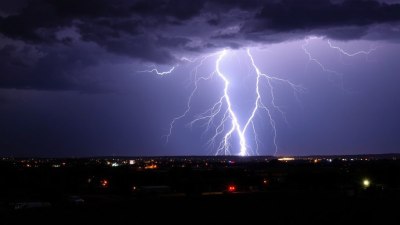The Truth About Why Lightning Strikes Certain Places
Explore why lightning tends to strike specific locations repeatedly and understand the science behind these patterns.

Image created with Flux Schnell
Lightning is one of nature's most powerful and fascinating phenomena, often capturing our curiosity due to its unpredictability and immense energy. While it might seem random, lightning does not strike just anywhere; instead, certain places are more prone to being hit multiple times. This article explores the scientific reasons behind why lightning tends to strike specific locations repeatedly, debunking myths and shedding light on the underlying natural mechanisms.
Understanding Lightning: A Brief Overview
Before diving into why lightning targets particular places, it is critical to understand what lightning is and how it forms. Lightning is an electrical discharge caused by imbalances between storm clouds and the ground or within the clouds themselves. These imbalances generate a buildup of electrical energy in the atmosphere.
During a thunderstorm, collisions between ice particles within clouds cause a separation of electric charges. The lighter ice crystals accumulate a positive charge, while the heavier hailstones become negatively charged, which leads to a strong electric field. When this field becomes strong enough to overcome the air’s resistance, a sudden discharge of electricity occurs, seeking the quickest pathway to neutralize the charge difference. This is what we see as lightning.
Why Do Certain Places Get Struck More Often?
The question of why some locations experience lightning strikes more frequently than others can be explained by several key factors such as geography, topography, and the physical properties of objects or landforms.
1. Height and Isolation
Lightning favors tall and isolated structures because these act as the shortest route for the electrical discharge to jump from cloud to ground. Lightning rods on buildings and tall trees are prime examples of this principle. The higher and more isolated an object is relative to its surroundings, the more likely it is to be struck.
For instance, the Empire State Building in New York City is hit by lightning around 25 times per year. Its height and prominence in the skyline make it an easy target for lightning bolts seeking a path to the ground.
2. Conductivity of Materials
Objects that conduct electricity well are more likely to be hit or to attract lightning. Metals, wet surfaces, and certain types of rock can facilitate the flow of electric charge. Therefore, metallic structures such as radio towers, power poles, and metal rooftops often experience more lightning strikes.
3. Topography and Local Weather Patterns
Some regions experience frequent thunderstorms due to specific local climate and geographic features. Tropical regions near the equator, mountainous areas, and places near large bodies of water often see more lightning activity. This increased frequency also raises the likelihood of certain sites being struck more often.
A good example is Lake Maracaibo in Venezuela, which experiences a remarkable natural phenomenon called the Catatumbo lightning. This location has an average of 260 storm days per year, causing vast amounts of lightning strikes that target the same general area.
4. Ground Elevation and Terrain Type
Higher elevations are more prone to lightning strikes because the distance between the cloud base and the ground is shorter. Mountain peaks and ridges often act as focal points for electrical discharges. Additionally, certain terrain types that promote convection or influence the electrical field can also lead to increased strikes in a localized area.
5. Human Structures and Urban Heat Islands
Urban areas sometimes show increased lightning activity due to the heat island effect, where cities are warmer than surrounding rural zones. The added heat can enhance storm development and turbulence, making urban environments slightly more prone to lightning strikes, especially to tall structures.
The Role of Lightning Rods and Safety Measures
Given that lightning tends to strike the tallest and most conductive targets, humans have devised technological solutions to protect structures and lives. Lightning rods, invented by Benjamin Franklin in the 18th century, are designed to safely channel lightning's electrical charge to the ground without damaging buildings.
These rods exploit the natural behavior of lightning by providing a preferred point for the discharge to strike. The rods are connected through conductive materials like copper wires to grounding systems that safely disperse the electrical energy into the earth. This reduces the risk of fire, electrocution, and structural damage.
Myths About Lightning Strikes and What Really Happens
Several myths surround lightning strikes, often fueled by misunderstanding or sensationalism. Some people believe lightning never strikes the same place twice, but this is false. Locations such as the Empire State Building and tall radio towers confirm multiple strikes over time.
Another common myth is that rubber soles or car tires protect people from lightning. In reality, it is the metal frame of a car acting as a Faraday cage that helps protect occupants, while rubber tires offer negligible insulation against lightning’s high voltage.
Additionally, people assume they are safe from lightning if inside buildings or beneath trees, but these are not always safe choices. While indoors generally provides protection, being near conductive objects like metal plumbing or electrical wiring can be hazardous. Standing under isolated trees during storms is especially dangerous because the tree often becomes a lightning path.
Statistical Patterns and Global Lightning Hotspots
Scientists monitor lightning activity globally using specialized satellite technology and ground-based sensors. This data reveals patterns that confirm lightning hotspots around the world. Some regions experience tens of millions of strikes annually, heavily influenced by climate, geography, and local atmospheric conditions.
The National Lightning Detection Network in the United States records an average of 25 million cloud-to-ground lightning strikes per year. Florida, known as the lightning capital of the U.S., experiences more frequent strikes due to its warm, humid climate and sea breezes that fuel thunderstorms.
Other notable lightning hotspots include Central Africa and parts of Southeast Asia. These regions have the right combination of convection, humidity, and terrain that lead to continual thunderstorm development and frequent lightning activity.
How Lightning Impacts Natural and Human Environments
Lightning strikes have both destructive and beneficial effects on environments. Naturally, lightning can cause wildfires by igniting dry vegetation, leading to significant ecological impacts. While destructive, these wildfires can also promote new growth and biodiversity in some ecosystems.
On the other hand, lightning contributes to the nitrogen cycle by breaking nitrogen molecules in the atmosphere and converting them into compounds plants can absorb. This natural fertilization process enriches soil and supports plant life.
From a human perspective, lightning poses serious safety risks and causes billions of dollars in damages annually. Electrical equipment failures, power outages, fires, and injuries are common consequences. Thus, education, awareness, and proper lightning protection systems are essential for reducing lightning-related hazards.
Predicting and Monitoring Lightning Strikes
Modern meteorology uses advanced methods to predict storms and lightning activity. Radar systems, electric field measurements, and satellite data help forecast thunderstorm development and lightning risk with increasing accuracy. Real-time lightning detection networks provide warnings to protect people and infrastructure.
Early warning systems and lightning monitoring help improve safety protocols for outdoor events, aviation, and construction activities. This detection technology relies on sensing the radio waves emitted by lightning strokes and mapping their precise locations.
Lightning Research and Future Technologies
Scientific research into lightning continues to evolve, aiming to deepen understanding and improve prediction capabilities. Studies focus on lightning initiation processes, lightning chemistry, and ways to harness the energy of lightning for technological uses.
Innovations include lightning-triggered sensors, enhanced grounding techniques, and materials designed to better withstand electrical strikes. There is also interest in developing systems that could potentially redirect lightning or safely dissipate electrical charges before they cause harm.
Moreover, lightning research contributes to space science by offering insights into electrical phenomena observed on other planets such as Jupiter and Venus.
Lightning does not strike randomly, but follows natural laws dictated by height, conductivity, geography, and weather patterns. Tall, isolated objects and places with conducive environmental conditions are more likely to be hit repeatedly. Understanding these factors helps in implementing effective safety measures against lightning hazards.
By combining scientific knowledge, advanced detection systems, and public awareness, society can better anticipate lightning risks and minimize its dangers. Lightning remains a powerful reminder of nature's formidable energy, but with proper respect and preparation, its impact can be managed effectively.











